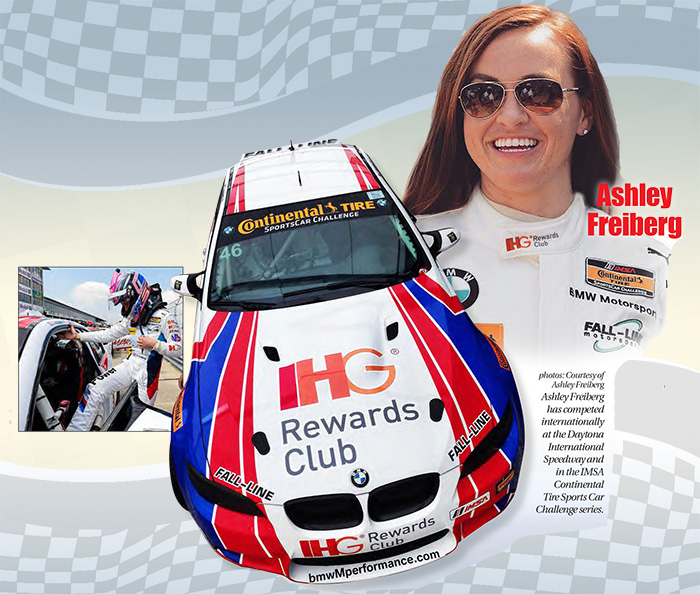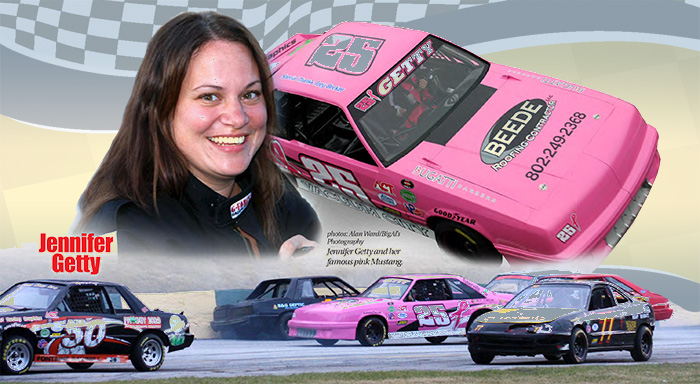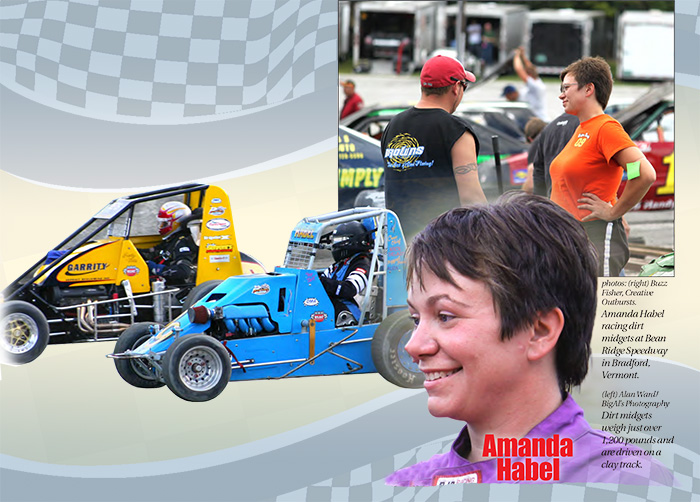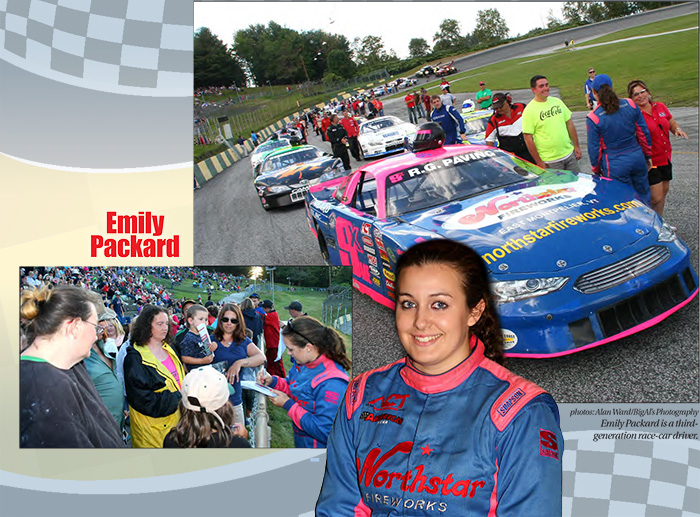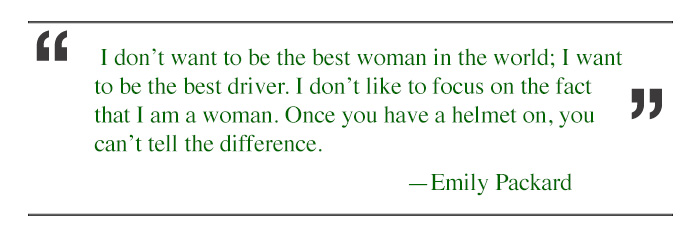| Racing Women: Stories from the Track | ||
| by Amy Brooks Thornton | ||
 |
||
Women have raced since 1897, but it wasn’t until the 1970s that the sport of car racing shifted into high gear for women. Along the way, a number of women pioneered the sport, among them Vermont’s own Shirley Muldowney, a Burlington resident, now 74 years old. Known as the “First Lady of Drag Racing,” Muldowney won the NHRA Top Fuel championship in 1977, 1980, and 1982, becoming the first person to win three Top Fuel titles, and eventually won a total of 18 NHRA national events. (For more on Muldowney, see sidebar, below the article.) A new lineup of women race-car drivers now lives and works Vermont. Though car racing continues to be predominantly a man’s world, and corporations providing sponsorship seem slow in figuring out how to leverage women drivers, this has not deterred these women from pursuing a sport that requires mental and physical strength and endurance, financial resourcefulness and business savvy, good mechanical know-how, and excellent interpersonal skills. And hunger for competition and the thrill of speed. |
||
|
||
| Ashley Freiberg | ||
| “When I get into a car before the race and I’m sitting on the grid while the national anthem is going on, I have this trigger,” Ashley Freiberg says. “I put my gloves on. I get into the zone and think about the race ahead of me.” To race well, says Freiberg, you have to “stay calm and be thinking your way through and strategize.”
Freiberg, age 23, an Illinois native and current resident of Bondville, Vermont, has raced her way to the top with perseverance and intelligence, pushing herself and her car “to new limits” through the “chaos” she calls car racing. In 2014, Freiberg was the first female overall race winner at Daytona International Speedway and for the Continental Tire SportsCar Challenge. The previous year, she was the first female overall North American GT3 Cup Challenge Winner at Watkins Glen. Just this winter, BMW named Freiberg a BMW of North America driver. Freiberg will also be a BMW “Ultimate Driving Experience” instructor, requiring her to sit in the passenger seat and help those who want to test drive their favorite BMWs through slaloms and maybe on the track. “Everything about this sport is hard work,” Freiberg says. Unlike the control you can have over yourself, in racing “you are driving with a machine that has a mind of its own.” Race-car training poses challenges. The cost of training at a racetrack is prohibitive. To replace on-track training, Freiberg uses a variety of methods to improve physically, mentally, and technically. “The number-one biggest thing is dealing with the heat,” Freiberg says. Trapped in her seat without much space between her and the hot engine requires endurance and aerobic training. You need good upper upper-body strength, Freiberg explains, “because you’re wrestling this machine around the racetrack. When dealing with g-loads,” the intense pressure gravity exerts on race-car drivers when accelerating through the corners, “you have to have good core strength so you can feel what the car is doing and you’re not just flopping around.” To strengthen, Freiberg trains at the gym, rock climbs, skate skis, and races in cyclo-cross races—bicycle racing over rough terrain using a specially outfitted road bike. She also has to make accurate split-second decisions under extreme pressure. To re-create the experience on the track, Freiberg watches in-car videos. In her division, a video camera is mounted inside the car to capture the race from the driver’s perspective. Freiberg screens the videos repeatedly, taking notes and writing her thoughts on how to improve. She also pores over the data for the car, such as the throttle and steering inputs, to determine the best driving techniques. Unlike races earlier in her career when she raced against all the same cars, Freiberg and the BMW M3 she drives are up against a variety of racing machines—Mustangs, Camaros, Aston Martins, and Porsches. “The BMWs are quick through the corners,” Freiberg says. “If I race against a Camaro or Mustang, [they have] good acceleration off the corners, but I am good on braking.” For Freiberg, the biggest challenge is money. To race a BMW M3, it costs between $200,000 to $400,000 to “share a seat” with another driver. And that’s just to pay for the car, the support team, and the race entries. It doesn’t include Freiberg’s travel, lodging, and food expenses while on the road. For now, her sponsors—BMW, IHG Rewards Club, and Bell Helmets—just cover the car. To pay for the rest, Freiberg coaches driving and works as a gardener in the summer. Her ambition? Ultimately, she would like to earn a living from racing, where prizes and sponsorship can add up to a hefty sum. And to drive a BMW M6 GT3—over a million dollars to drive. “Talent alone can’t get you really very far unlike other sports where you get scholarships if you’re good.” Freiberg says. “Racing is also a business, and it’s about marketing.” During two groundbreaking seasons, when Freiberg was leading the championship for the 2013 IMSA GT3 Cup Challenge series and in 2014, after her win at Daytona, she had to stop racing due to lack of funding. Freiberg says that her “single-most difficult challenge” was learning the business of car racing. However, Freiberg doesn’t shy away from challenge. Freiberg is her own business manager, marketer, and public relations expert. “I do pretty much everything by myself.” And she likes it. She wants to “have that personal connection” with her fans and sponsors. Freiberg has experienced gender discrimination on the racetrack—“guys blatantly running into me and crashing me out of a lot of races.” She’s mastering the art of “hitting them back, saying ‘don’t mess with me’” and earning her right to be there. It doesn’t affect her, Freiberg says, she’s learned to block it out. “As a woman you have to be careful in being too wrapped up in feeling that you’re different,” Freiberg says. “You could start taking things personally that you shouldn’t be.” Freiberg likes being a role model, “not just to young girls but to people in general.” Eventually, Freiberg wants to transition to being a coach to help younger women coming up through the sport. “There is so much I’ve learned that I wish I knew when I was younger.” |
||
|
||
| Jennifer Getty Mustang Street Stock Division Top speed: 55–65 mph |
||
| Jennifer Getty, age 37, races cars because it’s a challenge, she loves the fans, and it’s part of who she is—outside of motherhood, outside of her job as an administrative assistant at the Chittenden County Solid Waste District. “If I wasn’t racing and wasn’t a race-car driver,” says Getty, a resident of Cambridge, Vermont, and mother of two, “I wouldn’t have something for myself.” Like many mothers, it’s a balancing act for her—family and job weighted on one side, her needs and identity on the other. “My kids are my world,” Getty says, and racing is “the one thing I can do for me that I enjoy.”
Getty has a unique challenge. She has only one hand. Getty does not think of her one-handed driving—or living—as a disability and certainly not something that describes her. “People think it’s more challenging than it really is. I was born with one hand. I learned from the start.” For Getty, it’s just a matter of time and adaptation. “I get in [to the car] a few minutes before most people do. It does take me a little bit longer . . . I only drive with my left hand on the steering wheel. My right arm is on the shifter.” Getty mostly runs in second gear on the track, which makes it easier. If she needs to slow down, she can shift up to first using her specially designed shifter. “My arm only has to shift from first to second,” and sometimes into reverse. Getty does worry about breaking her left wrist or hand because then, she says, “I am really in trouble.” Though Getty’s one-handedness is, for her, just part of standard operating procedures, for anyone with two hands, it’s quite remarkable. She inspires her fans, and they, her. On July 5, 2009, Getty rolled her pink Mustang while racing at Thunder Road. Her first thought, as she was hanging upside down looking at the engine, which had dropped down in front, fluids pouring out from it, was about money. She was sure the engine was “done for”—too expensive for her to replace—and “it was the end of the road for racing.” With a pound of determination and an ounce of good luck, the engine was fixed at a decent price and she returned to the track. In her division, stock cars have to use the original motor and all the standard parts. The car can’t be purpose built with special parts as most sports racing cars are. However, the transformation from street car to race car is remarkable. Getty’s team installed a roll cage; removed the windows, door handles, locks, carpeting, console, and dashboard; and soldered the doors shut. They built a special dashboard and gauges: tachometer, battery, temperature, and boil pressure. But no speedometer—drivers focus on RPMs and lap times to judge their speed. “I know if I wreck my car, it could cost a lot of money to fix it as well as a lot of time,” Getty says, “other people’s time, not just mine.” Getty is always the conscientious and determined optimist. “Last year, opening race, my motor overheated and melted the pistons. But then the motor was fixed. I blew the motor again, but it’s fixable.” Yet, despite financial worries, Getty is generous. ”It feels great to be able to help others,” Getty says. She plans to donate 10 percent of this summer’s race earnings to causes concerning cancer. She’ll be racing her pink mustang with the breast cancer ribbon to raise $2,500 to send a child to Camp Ta-Kum-Ta. Located in South Hero, Vermont, the camp is for children who have or have had cancer. She’ll also participate in the Relay For Life, the American Cancer Society event to raise awareness and funds to fight cancer. “When I’m tired or burnt out, I think about the people who would miss me and my team . . . When you have fans who stick by you, when you finally win, it’s such an amazing feeling . . . [The fans] stick by you season after season, race after race. When you can finally thank them, it’s awesome.” |
||
|
||
| Amanda Habel Dirt midget USAC Dirt Midget Association division Top speed: 85 mph. |
||
As a little girl, Amanda Habel got the “itch” to race—and perhaps the motivation to race unusual cars—on one very special day. She remembers watching her father in a Run Whatcha Brung race at Thunder Road Speedway in Barre, a highly entertaining race where participants race whatever they have: Corvettes, BMWs, pickups, utility vans, limousines, bread trucks, and community shuttle buses. Now, as a racer and as fleet operations supervisor for Vermont Agency of Transportation, vehicles—from midget race cars to heavy road equipment—are Habel’s life, on and off the track. Habel, age 36 and a resident of Roxbury, Vermont, started racing stock cars—regular street cars not purpose built for the track—about eight years ago. Since then she has been “upside down in a race car more times than [she] can count.” Habel purchased her first race car for 75 dollars and drove it for a winter before repurposing it for racing. The second she found for 99 dollars on eBay. Habel wasn’t fazed that it had a blown motor. She placed a sticker on the dash that read, “Objects in mirror are losing.” Now Habel drives dirt midgets: dirt because they’re driven on a clay track and midget because they’re tiny. Stock cars weigh about 3,300 pounds with the racer in it. Habel’s dirt midget with her in it is about one-third that weight, a little over 1,200 pounds. Midgets may be small, but they’re fast. With her 170 horsepower engine, Habel’s midget reaches 75 to 80 miles per hour on the quarter-mile track. With double the horsepower, midgets can reach over 130 miles per hour. Fast for a diminutive car. According to Habel, dirt midgets are some of the hardest cars to drive. “It’s like driving an extremely high-powered go-cart. The steering is very [finicky] . . . everything has to be very smooth and coordinated. You can’t bump into each other because the chances are you’re going to run right over the rear wheel of the car in front of you and flip over.” But even though the little cars are “often skidding sideways on the track,” midget drivers race clean, “no games,” and have fewer accidents, which appeals to Habel who supports her family. The track’s variability makes racing dirt midgets exciting. In dirt track racing, “the track changes every lap. It changes depending on the division that went before you.” If the track gets wet, the layer of slippery mud can make the midgets spin. It helps, Habel says, to have a car with low gears and more traction in those conditions. And maybe to be a Vermonter, familiar with mud. No wonder dirt midget racing is so popular in Vermont.
For Habel it’s not always been easy being a woman on the track. “I actually had one driver ask me ‘What are you doing on a racetrack? Shouldn’t you be barefoot and pregnant in a kitchen?’” Habel recounts. She points out that these comments usually happen after a track accident, when tensions are high. “Just because I have boobs,” Habel says with a smile, “doesn’t mean I can’t drive. I ask them if they would like to discuss what actually happened or are they going to keep putting me down?” She prefers to watch the videos of the race before talking about an incident because the high speeds make it hard to determine fault. “I point out to them that [my being female] has nothing to do with it,” Habel says. To save money, Habel largely relies on her mechanical skills to maintain her midget herself. “I know quite a bit about fixing my car,” Habel says. Her 14-year-old daughter, Aliza, is on her pit crew. “I think it’s . . . important that all girls learn some sort of auto mechanics,” says Habel. “My dad started teaching me when I was 8. So many women get taken advantage of because they don’t understand how a car works and what’s needed to maintain it and keep it safe.” Though dirt midgets are cheaper to run than other race cars, the expenses—gas, food while at the track, parts when the car is wrecked—are not insignifcant. “If you don’t have a lot set aside in your [car-racing] fund, there’s stress that comes while you are trying to make those repairs.” Habel doesn’t like asking other people to fund her “for having a good time.” She likes to earn the extra money on her own. In order to race, Habel has held two or three jobs during the winter for the last seven years, working nights and weekends, cleaning private houses and condominiums at Sugarbush. Luckily her new position at the Agency of Transportation has freed her from juggling jobs. To keep living expenses down, Habel and her family live in a single-wide trailer. It may not be “glamorous,” but says Habel, “Right now it’s more important to me to have fun and enjoy myself doing what I love to do. “ Habel admits she keeps racing because she is “an adrenaline junkie.” “The thrill never goes away. Just sitting waiting to go out on the track. The butterflies in the pit of your stomach . . . I like competition.” Among the best moments? Having her daughter in the car with her in victory lane. She was only 10 at the time, and she gave a little speech. She had “tears of joy,” says Habel, “She was crying while trying to talk.” |
||
|
||
| Emily Packard Chevy Impala and Ford Fusion American Canadian Tour series Top speed: 125 mph |
||
| Emily Packard, age 18, sits on her kitchen counter, confident, smiling, and enthusiastic, her long hair neatly tied back. Her mother leans on the island, listening intently to her daughter’s answers, throwing in suggestions from time to time. The Packard family, whose members live in East Montpelier, Vermont, work as a team, both in auto racing and business. Emily Packard, who has been racing go-karts since age 9, is a third-generation race-car driver and the first female driver in her family. Yet her gender is not what drives her.
“I don’t want to be the best woman [driver] in the world, I want to be the best driver,” says Emily Packard, “I don’t like to focus on the fact that I am a woman. Once you have a helmet on you can’t tell the difference.” Packard races three nights a week in the summer, each race taking up to two hours to drive. On 80- to 90-degree days, it can get up to 110 degrees inside the non-air-conditioned race car. It’s physically exhausting. “The forces in the car are literally pushing you back in the seat and pushing you to the side. You have to fight the forces,” Packard says. “When the car is tight, you are grabbing that wheel. You have got to have arm strength” and endurance. Packard adds, “I don’t want to be the best woman in the world; I want to be the best driver. I don’t like to focus on the fact that I am a woman. Once you have a helmet on, you can’t tell the difference.” “I know that being a female gets me a lot more attention,” says Packard, who is currently ranked eighth in the Vermont State Late Model Championship and fourth in the American Canadian Tour driver standings. Gender issues are still present, she says, and “it’s unfortunate.” Packard explains that unlike high school, where teams are organized and compete by gender, in auto racing, where males and females are mixed, gender issues are more pronounced. “The hardest moment is entering a new division,” Packard explains. “Every time you move up, you’re learning the car, learning the competition, and gaining respect. That’s a pretty tough thing. Being a female doesn’t help. [Some say] ‘she’s just going to be a roadblock and get in the way.’” Packard finds that male drivers more often don’t race “clean” against female drivers. Some use tactics to make the race as difficult as possible. They “chop you,” (when a driver rapidly maneuvers their car across the nose of another car), “bump you,” and “take you out” (when a driver intentionally makes another car spin, or pushes the car into the wall around the track or into other cars). “Anything to gain the position on you,” Packard says. But Packard is tough. “I’ll play dirty if you play dirty with me. If someone is intentionally going to try to take me out, I’m going to take them out. I’m not playing the nice girl anymore. If you take me up to the wall, we’re going to get into it. And it’s not going to end nicely.” However, male race-car drivers have come to Packard’s aid, most memorably at Thunder Road Speedway in Barre, Vermont. Undeterred, a week later Packard returned and won; she was the youngest driver to win at Thunder Road. Packard is not afraid of wrecks, but she has endured plenty of pain: “You get bruises in all the spots where the [seat] belts are.” Although she’s never broken a bone or had a concussion, she developed scoliosis, curvature of the spine, from a go-kart accident when she was 9.
Packard adores and works hard for her fans who live as far away as Tennessee. “I give people a chance to talk. I’ll stop andtalkto people in the stands. I always make sure I have something for my fans.” Because her cousin was diagnosed with leukemia at age 16, Packard goes to great lengths to pay special attention to fans battling cancer. When she drove in the Light The Night Walk, a fundraising event to support leukemia and lymphoma research, she met a family in which the father had just undergone surgery for lymphoma. Packard visited him and the family in the hospital, gave a birthday cake resembling Packard’s car to the youngest daughter, and took the whole family for a ride in her car at Devil’s Bowl Speedway in Fair Haven, Vermont. Packard also works with one of her sponsors, Be The Match, which manages the largest bone marrow registry in the world, by bringing her car up to the Berlin Mall as an incentive for people to sign up to be bone marrow donors. She also has a lot of fans who have special needs, “who come to the shop to check everything out. It gives them hope,” Packard says. Packard would be a high school senior except that she felt school wasn’t challenging. She leveled up and enrolled in Vermont’s Early College Program. As a freshman at Community College of Vermont, she takes five classes, two of them four-credit classes, toward an associate’s degree in business. “Now I’m learning things I want to learn because I’m taking things I want to take,” she says. This past winter, she balanced her schoolwork with working in the family business, Packard Fuels, “ripping apart shelves, cleaning, plowing” and running machines, including loaders, dump trucks, and plows. After her sophomore year, Packard plans to take a year off to work for Packard Fuels full-time. “I want to take over the family businesses and keep doing what I love,” Packard says. But for now, she reflects, “You got to take one day at a time. You never know what’s going to happen. You can’t predict the future. I could get into a car accident tomorrow. I just like to do the best I can and hope that will get me where I want to go.”
|
||
|
||
Amy Brooks Thornton, a multimeda journalist and educator, was formerly at ABC News with Peter Jennings and was the founder and director of Pacem School and Homeschool Center in Montpelier, Vermont.
|
||
